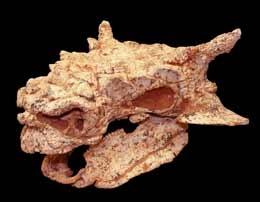Published online 2 February 2009 | Nature | doi:10.1038/news.2009.60
Palaeontologists criticize publication of specimen with questionable origin
Palaeontologists are criticizing a new article on an armoured dinosaur fossil because the 80-million-year-old specimen may have been taken illegally from the Gobi Desert. The prominent California neuroscientist who purchased the fossil five years ago says he will send it back, to China or Mongolia, if someone can demonstrate that laws were indeed broken.
 The 80-million-year-old specimen is of an ankylosaur.Western Paleontological Laboratories
The 80-million-year-old specimen is of an ankylosaur.Western Paleontological LaboratoriesVilayanur Ramachandran, who directs the Center for Brain and Cognition at the University of California, San Diego, says that he bought the skull for US$10,000 at the Tucson Gem, Mineral and Fossil Showcase in Arizona, long troubled by the sale of illegally-imported fossils (see 'The biggest, wildest fossil market in the west').
Ramachandran, an amateur fossil collector, was walking around the displays with Clifford Miles, of Western Paleontological Laboratories near Salt Lake City, Utah, when Miles pointed out the perfectly preserved skull. "He said, 'You buy it, I'll name it after you,'" says Ramachandran.
Miles did just that on 10 January, in an article1 in an Indian journal that names the bull-like ankylosaur Minotaurasaurus ramachandrani. But there is no clear paper trail that guarantees the fossil was acquired through legal channels; in fact, when it was cleaned in 2003 in Denver, the museum made sure the work was done outside the museum because of the fossil's suspect origin.
"It is totally inappropriate to publish on this specimen; it is stolen patrimony," says Mark Norell, curator of vertebrate palaeontology at the American Museum of Natural History in New York, who does field work in Mongolia and China.
Important origins
Miles acknowledges that the specimen's provenance is questionable, but says that publishing its details will help shed more light on the fossil. "We need to publish on fossils like this so people can learn where they came from," he says.
Miles and his brother, Clark, attempted to publish the fossil's description in 2006 in a Polish journal, but their submission was rejected because the fossil seemed to have been obtained illegally from Mongolia. Two years ago they described it as coming from the Barun Goyot Formation in Mongolia, but now say they "hit a dead end" in trying to confirm its origin.
In Tucson, the fossil was displayed by Colorado cast-maker Robert Gaston for Hollis Butts, a dealer in Japan. Ramachandran says that he purchased it from Butts, who couldn't be reached for comment.
Philip Currie, a palaeontologist at the University of Alberta in Edmonton, Canada, says that publishing work about such fossils only encourages the raging illegal trade. "This really flags a horrendous problem in Mongolia, where a frightening number of specimens are smuggled abroad," says Currie. Bolortsetseg Minjin, who directs the Institute for the Study of Dinosaurs in Ulaanbaatar, Mongolia, says that the rock the skull is encased in suggests it probably came from Mongolia. "It should be sent back," says Minjin, who is also a postdoctoral researcher at the Museum of the Rockies in Bozeman, Montana.
Ramachandran says that he would be happy to repatriate the fossil to the appropriate nation, if someone shows him "evidence it was exported without permit". For now, the specimen rests at the Victor Valley Museum, an hour's drive east of Los Angeles in the isolated town of Apple Valley.